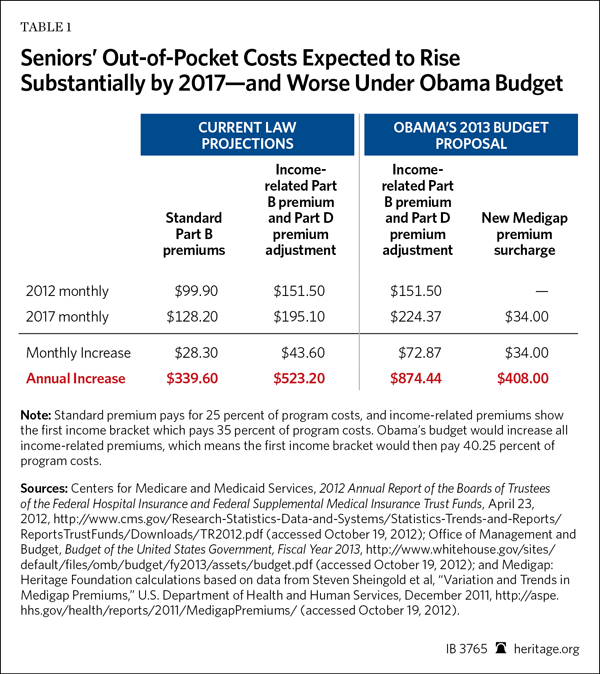Today’s seniors are facing higher Medicare costs. Over the next five years, current law, as amended by the Patient Protection and Affordable Care Act (PPACA, also known as “Obamacare”), and President Obama’s budget proposals guarantee higher costs for today’s seniors.
Status Quo Hikes
The 2012 Medicare trustees report says that, over the period 2012 to 2017, seniors’ standard Medicare Part B monthly premiums will jump from $99.90 to $128.20, while their Part B deductibles will rise from $140 to $180.[1] Seniors’ Medicare hospital deductible will increase from $1,156 to $1,336, while their daily hospital coinsurance will climb from $289 to $334. And for seniors in the hospital beyond 90 days (lifetime reserve days), the per diem coinsurance costs are estimated to reach $668 by 2017.[2]
In other words, under current law, anyone over 65 who fails to buy private catastrophic insurance coverage is taking a huge risk.
Obamacare Impact
Obamacare already mandates $716 billion in Medicare payment cuts over the next 10 years, but these cuts are not targeted at specific instances of “waste, fraud, and abuse.” Rather, they are across-the-board changes in Medicare payment formulas for hospitals, nursing homes, home health agencies, hospice agencies, and Medicare Advantage plans.
Moreover, as every responsible analyst has noted, one cannot simultaneously use that money to pay for Obamacare and extend the life of the Medicare trust fund. Notwithstanding the tiresome claptrap that Medicare payment cuts affect only providers and not beneficiaries, cuts in funding for services directly affect those persons who depend on those services.
Obamacare will also increase Medicare taxes. The law raises the Medicare payroll tax, which funds the hospital insurance (HI) trust fund, on high-income earners from 2.9 percent to 3.8 percent and also extends the 3.8 percent Medicare tax to investment income. Together, this is the largest tax increase in Obamacare, costing taxpayers $318 billion from 2013 to 2022.[3]
However, the Medicare payroll tax revenue is again double-counted as paying for new spending and extending the life of the trust fund.[4] As for the tax on investment income, Medicare trustee Charles Blahous explains, “Though termed an ‘Unearned Income Medicare Contribution’ (UIMC) under the law, this revenue would not come from Medicare’s traditional contribution base and it would not be allocated to a Medicare Trust Fund.”[5]
Higher Premiums
President Obama has also proposed major Medicare changes in his fiscal year 2013 budget proposal. For Medicare Parts B and D, Obama’s budget plan would increase premiums by 15 percent for upper-income seniors. But by 2035, those premium increases would be expanded to cover 25 percent of all Medicare beneficiaries. Thus, President Obama’s proposed special premium increase on upper-income retirees would substantially increase the number of seniors paying the tax.
According to Heritage’s Center for Data Analysis calculations, an individual with an income of $85,000 in 2017 who is enrolled in Part B and Part D would have a combined premium increase of $874.44 for that year. For a married couple with an income of $170,000 in 2017 enrolled in Part B and Part D, the combined premium increase for the couple would be $1,748 for that year.
While there is a large and growing consensus among a variety of analysts on the need to expand the scope of “means testing,” a better approach is to reduce the government subsidy for upper-income seniors rather than foster the illusion of the subsidy by making seniors pay more.[6]
New Fees
President Obama would also impose new fees on baby boomers joining Medicare beginning in 2017. His 2013 budget proposal introduces a $25 increased Part B deductible for new beneficiaries in 2017, 2019, and 2021 and a $100 copayment for home health services in certain cases.
While there is a broad consensus on the need to curb the “first-dollar” coverage that drives up Medicare costs, President Obama proposes a premium surcharge—a kind of “premium tax”—for new beneficiaries who choose a Medigap plan with first-dollar or near-first-dollar coverage. This approach would affect most new beneficiaries.[7] A better approach would be to restructure Medicare’s cost-sharing arrangements rather than adding a new “tax” to seniors.

New Drug Costs
The Obama Administration’s proposed new out-of-pocket costs will be coupled with increased premiums for all Part D beneficiaries. Obamacare spends an estimated $48 billion closing the “donut hole,” the congressionally created gap in drug coverage in which beneficiaries must pay 100 percent of the total costs up to a specific “catastrophic” threshold ($4,750 in 2013). When that threshold is reached, the insurance resumes payment.
Obamacare closes the “donut hole” by 2020. While out-of-pocket costs for Medicare Part D will be reduced, the changes enacted under the new health law will come at a higher premium price. Thus, according to the Congressional Budget Office’s (CBO) 2010 estimate, “enacting those changes would lead to an average increase in premiums for Part D beneficiaries of about 4 percent in 2011, rising to about 9 percent in 2019.”[8]
These premium increases must be understood in terms of how the Part D donut hole actually affects today’s seniors. While the average premiums of all Part D beneficiaries will increase, note that of all 48.6 million Medicare enrollees in 2011, only 3.6 million actually fell into the donut hole.[9] Moreover, approximately 11 million enrollees get low-income subsidies for drug coverage, including coverage in the donut hole. Today, most private health plans already provide additional coverage for beneficiaries who might find themselves in the donut hole. For 2012, 52 percent of all plans provide generic or some generic and some brand-name drug coverage in the donut hole.[10]
Out of Options
Obama’s latest budgetary scheme for cost-shifting to seniors is just another indication that the Administration and its allies on Capitol Hill are running out of options. They have already cut the Medicare provider payments to achieve a 10-year “savings” estimated at $716 billion, but most of those “savings” will finance Obamacare.[11] In a letter to Senator Jeff Sessions (R–AL), ranking member of the Senate Finance Committee, the CBO writes, “Unified budget accounting shows that the majority of the HI trust fund savings under PPACA would be used to pay for other spending and therefore would not enhance the ability of the government to pay for future Medicare benefits.”[12]
Americans may differ on Medicare reform or the right future for Medicare, but one thing is certain: Under the Obama plan, seniors will pay more—a lot more—and they will pay this steep price in many different ways, including a loss of access to care from demoralized doctors and other medical professionals. Bottom line: Medicare “as we know it” is already a thing of the past.
—Robert E. Moffit, PhD, is Senior Fellow in the Center for Policy Innovation, Rea S. Hederman Jr. is Assistant Director of and Research Fellow in the Center for Data Analysis, and Alyene Senger is Research Assistant in the Center for Health Policy Studies at The Heritage Foundation.



